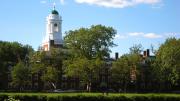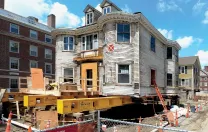Additional information has become available since the Faculty of Arts and Sciences’ (FAS) “Strategic Assessment Report” on House renewal was published in late May; these data make it possible to describe more fully the project’s financial foundations and needs (as described in the main story, published in the September-October 2016 Harvard Magazine).
As reported, FAS disclosed that as of March 31, it had secured gifts and pledges of $230 million toward a campaign goal of $400 million for the project (a target subsequently raised to $450 million, reflecting the expanded scope of Winthrop House work, including substantial new construction plus renovation of additional buildings being incorporated into the House).
New Financial Data
Decapitalizations. The “Financing & Affordability” section of the report noted that the early stages of House renewal depended heavily on “decapitalizing” appreciated endowment funds. FAS’s annual financial reports disclosed that $391 million of decapitalizations were effected in fiscal years 2012 through 2015, but did not specify their uses. It turns out that renewal-related decapitalizations have totaled $358 million:
- $253 million for project costs; and
- an additional $105 million to pay down existing FAS debt (most incurred for construction of science facilities in the prior decade)—in effect, creating room for future House-renewal-related borrowing (which has always been envisioned as part of the financial plan).
Project Spending. Through this past May, FAS had spent $391 million on House renewal, for:
- planning and architectural costs;
- construction of the completed Stone Hall (part of Quincy House); Leverett McKinlock; and Dunster projects; plus preliminary work on Winthrop—where full construction has been under way since just after Commencement this past May; and
- design and other preliminary work for Lowell, scheduled to begin next summer and to last two years.
Funding for the costs incurred so far reflects a mix of the proceeds from those FAS decapitalizations, the use of FAS reserves, and cash payments made on capital-campaign gift pledges. The total cost will increase rapidly with the size and complexity of subsequent projects. (For example, compared to the more readily accessible Houses where construction has already been completed or is under way, Lowell and Kirkland have enclosed courtyards, requiring materials and equipment to be hoisted into the site—an expensive undertaking. Eliot is large and relatively enclosed, too. Adams presents its own challenges, with multiple smaller buildings more scattered across the House as a whole.)
The Effect on the Faculty’s Fisc
The assessment report noted, “Decapitalizations taken to date will remove approximately $25 million of available cash from the FAS operating budget by the conclusion of the program. The operating impact is compounded by the House renewal funding model’s focus on utilizing unrestricted endowments and Dean’s Reserves.” Reliance on the latter sources limits the dean’s flexibility to invest in new academic priorities or meet unplanned contingencies—an unwanted constraint.
The basis for estimating the $25-million effect on FAS cash was not disclosed. With confirmation that $358 million has been decapitalized for House renewal, the anticipated effect can now be calculated as follows, through fiscal 2025 (the period used in arriving at the figure):
- Apply a 4.5 percent distribution rate to the value of endowment funds (at the lower end of the distribution rate the Corporation typically applies in determining the monies to be forwarded to Harvard’s schools and units for budgeted annual operating expenses). That yields approximately $16 million annually from the $358 million of decapitalized funds.
- Apply FAS’s assessment rates—in total, 18 percent—to those $16 million in annual distributions, yielding about $2.9 million of fungible cash.
- Multiply that $2.9-million figure by the number of years in the planning period, yielding approximately $26 million through fiscal 2025.
Several variables make this gross calculation inexact.
- First, it assumes that all the decapitalizations were from appreciated funds associated with restricted endowments (those dedicated to professorships, for example, or book-acquisition funds), distributions from which are subject to FAS’s assessments to support its operation and other overhead costs. But in fact, FAS had to rely heavily on decapping unrestricted endowments, too; these are not subject to the assessments, because they already provide fungible cash. (The necessity of tapping them for this purpose was therefore undesirable for FAS’s near- and long-term finances—the effect referred to in the second sentence from the assessment report, cited above.)
- Second, the calculation assumes that all the decapitalizations took place at a single time.
- Third, the calculation does not incorporate any growth in the sums that would actually be distributed in fiscal 2017 through 2025, reflecting estimated appreciation in the underlying assets had they been retained and invested within the endowment, and/or changes in the distribution rate.
Those refinements aside, the cumulative estimate of $25 million in forgone cash captures the effect only through fiscal 2025. But the effect on FAS’s finances is not neatly finite: it is a permanent impairment that could be expected to grow over time alongside anticipated endowment gains.
The Project Prospects
FAS’s assessment report makes the case for reorienting the timing of future House renewal projects to accommodate:
- two-year construction schedules (at Lowell, for instance), versus the prior 15-month jobs (at Dunster and earlier sites);
- pre-construction fundraising for each specific project; and
- House-specific fundraising.
It also argues for debt financing sooner rather than later, both to continue the construction momentum and, presumably, take advantage of historically low interest rates. And it warns about 5 percent to 7 percent annual construction inflation in Greater Boston: a severe challenge for a 10-year program with an initial estimated price tag of $1.4 billion or more. (The tight local market for construction workers—and the scale and complexity of the work at Houses like Lowell—are factors that encourage adoption of a two-year, rather than two-summers-plus-one-year, schedule for future renovations.)
Beyond those adjustments—and whatever decision is made to resort to debt financing (and the costs to FAS of doing so)—a larger issue looms: how to pay for House renewal in its entirety.
- FAS clearly does not want to have to decapitalize more endowment assets (if indeed such funds are even available)—so it is appropriate to assume that the roughly $360 million provided that way is the maximum.
- FAS fundraisers hope to meet their $450-million goal for House renewal.
- That leaves a gap of, conservatively, $600 million to complete the eight Neo-Georgian River House projects in this “phase one” of House renewal. (Whatever sprucing-up the more recently constructed sections of those Houses and the Radcliffe Quad may require has been left for future consideration.)
It is highly unlikely that new debt can bridge that entire gap. From a peak of $1.08 billion in debt reported in fiscal 2009, FAS labored mightily to reduce such obligations to $869 million in fiscal 2014. As a result, the assessment report happily notes, the share of FAS’s operating budget devoted to debt service declined from 11.4 percent in fiscal 2008 to 7.4 percent in fiscal 2014. That progress reflects both normal maturities and atypical steps such as substantial early principal payments (tied to decapitalization and use of unrestricted reserves), and funding of other capital projects without the usual resort to debt. The latter measures are not routinely available; expended reserves cannot be expended again; and the decline in debt outstanding appears, in fact, to be over, since the fiscal 2015 sum outstanding crept up to $875 million. FAS has plenty of other building projects on its plate, too.
Debt has to be serviced and ultimately repaid. Whether it pays the University’s blended cost for borrowing (currently about 4.6 percent) or gets some special dispensation to enjoy a lower, market rate, FAS would be hard-pressed to let its indebtedness balloon by two-thirds or more—a worrisome level of leverage, and indeed a concern for Harvard as a whole were such sums to be financed entirely by issuing new debt. (Harvard, too, has big ambitions, including the $1-billion applied sciences and engineering facilities in Allston. No financing plan is in the public realm, but it certainly includes the hoped-for fruits from University fundraising, likely augmented by internal sources of cash and possibly additional debt.)
So, as House renewal proceeds, delivering twenty-first-century accommodations for undergraduates now and in classes to come through improvements in planning and execution described in the assessment report, its scale and ultimate expense pose continuing challenges to FAS and the University. The implications may extend even beyond the epic scope of The Harvard Campaign, and the tours of duty of the FAS and University administrators who are conducting it with record-setting success today.










